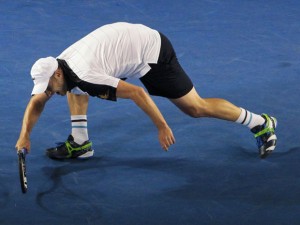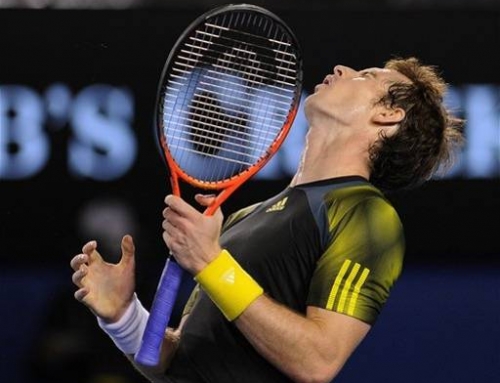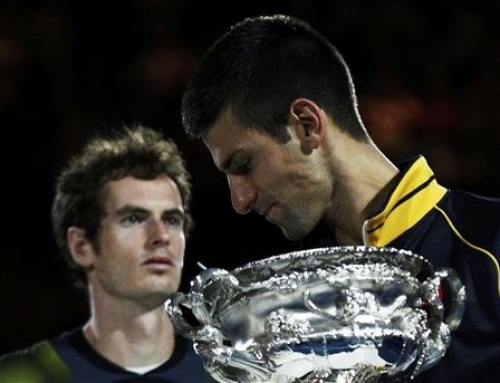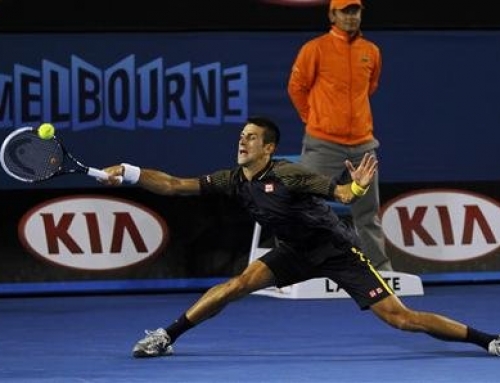 Andy Roddick and Lleyton Hewitt go way back. Hewitt was contending for Slams nearly a decade ago winning a US Open in 2001. Roddick followed suit two years later. The two were considered rivals for the number 1 spot. All this was, of course, prior to Federer breaking out and leaving both of them in the dust. Even though neither are reliable Slam contenders, especially Lleyton Hewitt, they’ve both had staying power. Roddick, at the very least, could hang his hat on being in the top ten for many years, a feat that was broken only last year when he slipped outside the top ten. Hewitt hasn’t been in the top ten in years either, a combination of injury and a playing style that was more suited to the 1990’s than the 2010’s.
Andy Roddick and Lleyton Hewitt go way back. Hewitt was contending for Slams nearly a decade ago winning a US Open in 2001. Roddick followed suit two years later. The two were considered rivals for the number 1 spot. All this was, of course, prior to Federer breaking out and leaving both of them in the dust. Even though neither are reliable Slam contenders, especially Lleyton Hewitt, they’ve both had staying power. Roddick, at the very least, could hang his hat on being in the top ten for many years, a feat that was broken only last year when he slipped outside the top ten. Hewitt hasn’t been in the top ten in years either, a combination of injury and a playing style that was more suited to the 1990’s than the 2010’s.
So when the two head on court, it’s like a reunion tour from a decade ago. To be honest, Andy Roddick continues to do new things with his game. The last few years, he’s played a counter puncher style using his big serve to win a few free points and patient play to win others, then pressure his opponents on their game. It worked fine for most players ranked outside the top ten, but rarely made an impression on the top players like Federer and Nadal who could be just as patient but were more willing to go for big shots and make them.
Andy Roddick has been accused of being too passive, so it appears he’s spent his off-season working on being more offensive. He was able to apply some of that in his first round win over Robin Haase. Roddick took the first set over Hewitt, but early in the second, he landed awkwardly on his right leg and pulled his right hamstring. He would later say that he could move fine if he didn’t have to stretch out on that side, but obviously, tennis is a running game, so you can’t avoid that. Although Roddick tried to hit harder and shorten the points, he gave up too much. Hewitt took sets 2 and 3 at which point Roddick had to retire. He felt that this was something that would take a few weeks to recover from so he wouldn’t be able to play Davis Cup though he felt he probably wouldn’t have played anyway.
Final score: 36 63 64 ret.
Roddick wasn’t the only upset victim. In the battle of the Frenchman, Gilles Simon took on Julien Benneteau. Benneteau had reached a final last week in Sydney where he lost to Jarkko Nieminen. Due to a rain delay of the finals, Benneteau didn’t arrive to Melbourne until Sunday (he was expected to arrive on Saturday). Fortunately, he was on the top half of the draw and didn’t have to play singles until Tuesday. Apparently, a week’s worth of play at Sydney has left Benneteau pretty sharp. Benneteau won his first round against Karol Beck pretty handily in straight sets. He faced countryman Gilles Simon who struggled in five sets to beat a player from Thailand ranked about 200.
Simon also found himself down two sets to none after two hours of play before coming back to take sets 3 and 4. However, it wasn’t enough as Benneteau took the fifth set handily. Final score: 75 76 16 36 62
These two weren’t the only Frenchmen in action. Jo-Wilfried Tsonga played early in the day and had a comfortable straight set win over Ricardo Mello of Brazil. Tsonga will take on another Portugeuse speaking player, this time, from Portugal. Frederico Gil upsets Marcel Granollers in four sets. Tsonga appears set up to meet either countryman Benneteau or Japanase number 1 Nishikori in the fourth round.
Gael Monfils also played a Brazilian, namely, Thomaz Bellucci. The left-hander took the first set before Monfils came back in four sets. Final score: 26 60 64 62
Early in the day, Novak Djokovic continued to play matches as if they were practice rounds, relaxed and in total control. Djokovic beat Colombian, Santiago Giraldo, 63 62 61. Up next for Djokovic is one half of the marathon match, Frenchman, Nicolas Mahut. Mahut beat Ito, a wildcard from Japan, in four sets. Ito and Soeda had great performances in Chennai showing that the Japanese have more than Nishikori at the world-class level. Djokovic continues to look like he’s playing well, but he’s really not faced anyone too problematic. Mahut has a big serve, but isn’t expected to pose too many problems. If Raonic gets past Hewitt, then Djokovic might have his first real match of the tournament.
Raonic needed four sets to get by German, Philipp Petzschner. Raonic was asked what he did during the offseason. He said he serves just fine, but he felt his return game needed work so he spent time on that. Up next for Raonic is Lleyton Hewitt.
And, although this tournament is the Australian Open, the French generally fare better on hard courts than clay courts, and Murray appears likely to face a series of Frenchman if he wants to win the title. After playing a tight four setter against Ryan Harrison, Murray played much lower ranked Edouard Roger-Vasselin. His father also played on the tour and once reached the French Open semifinals upsetting Jimmy Connors in the quarterfinals.
Murray started this match is quick style with a 50 lead and eventually took the first set, 61. Although Murray continued to get chances to break, few breaks were forthcoming after that. Roger-Vasselin’s consistency and aggressiveness, especially coming to net, went up while Murray was missing a little long here, a bit in the net there. Compared to the first match, Murray started to hit more aggressively off the ground even hitting a 115 mph forehand winner late in the third set. Although the outcome was never in doubt and Murray held serve fine, he might be a touch frustrated that he didn’t get the breaks he wanted which would have kept the match short. Like Federer, Murray does tend to look at these matches in a positive manner, pointing out that he didn’t lose serve, despite not breaking as much as he might have wanted.
He’ll point to a relatively high first serve percentage, nearly 70%, partly due to taking the pace off some of his first serves, and that he had many more winners and fewer errors than his opponent.
Murray will now take on the serve-and-volleying Michael Llodra who needed five sets to beat American/Russian Alex Bogomolov. If Murray gets past Llodra, he may have to play Monfils, then Tsonga before reaching a potential Djokovic in the semis. This is a pretty tough draw, perhaps the toughest in the tournament.






![[Aussie Open Final] Can Andy Murray beat Novak Djokovic?](https://www.essentialtennis.com/wp-content/uploads/2013/01/20130126andy-500x383.jpg)
![[Day 13, Aussie Open] Bryan brothers win 13th Slam with Aussie doubles title, Kyrgios wins boys title](https://www.essentialtennis.com/wp-content/uploads/2013/01/20130125bryan-500x383.jpg)